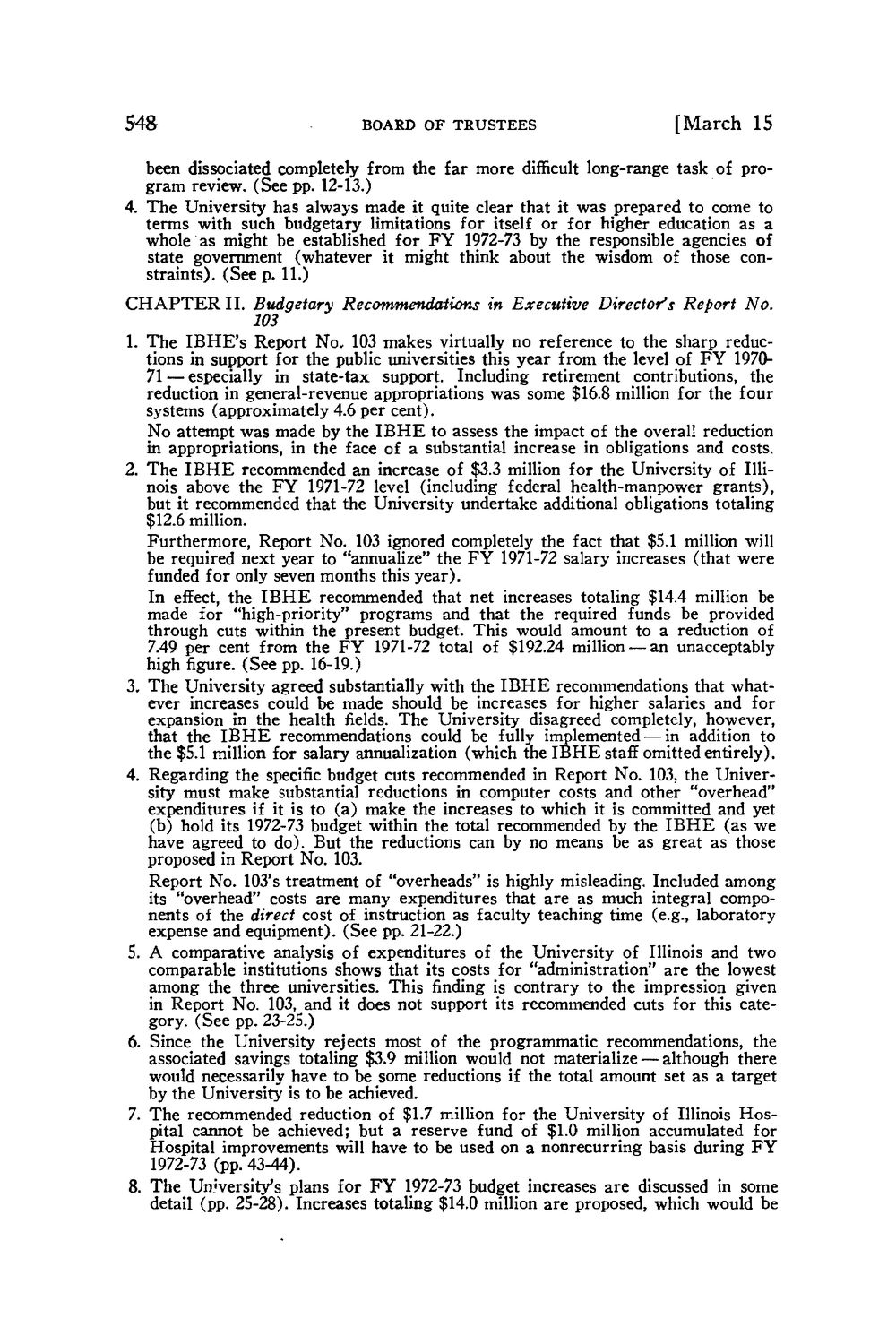| |
| |
Caption: Board of Trustees Minutes - 1972
This is a reduced-resolution page image for fast online browsing.

EXTRACTED TEXT FROM PAGE:
548 BOARD OF TRUSTEES [March IS been dissociated completely from the far more difficult long-range task of program review. (See pp. 12-13.) 4. The University has always made it quite clear that it was prepared to come to terms with such budgetary limitations for itself or for higher education as a whole as might be established for F Y 1972-73 by the responsible agencies of state government (whatever it might think about the wisdom of those constraints). ( S e e p . 11.) C H A P T E R I I . Budgetary Recommendations in Executive Director's Report No. 103 1. The I B H E ' s Report No. 103 makes virtually no reference to the sharp reductions in support for the public universities this year from the level of F Y 197071 — especially in state-tax support. Including retirement contributions, the reduction in general-revenue appropriations was some $16.8 million for the four systems (approximately 4.6 per cent). No attempt was made by the I B H E to assess the impact of the overall reduction in appropriations, in the face of a substantial increase in obligations and costs. 2. T h e I B H E recommended an increase of $3.3 million for the University of Illinois above the F Y 1971-72 level (including federal health-manpower grants), but it recommended that the University undertake additional obligations totaling $12.6 million. Furthermore, Report No. 103 ignored completely the fact that $5.1 million will be required next year to "annualize" the F Y 1971-72 salary increases (that were funded for only seven months this year). In effect, the I B H E recommended that net increases totaling $14.4 million be made for "high-priority" programs and that the required funds be provided through cuts within the present budget. This would amount to a reduction of 7.49 per cent from the F Y 1971-72 total of $192.24 million — a n unacceptably high figure. (See pp. 16-19.) 3. The University agreed substantially with the I B H E recommendations that whatever increases could be made should be increases for higher salaries and for expansion in the health fields. The University disagreed completely, however, that the I B H E recommendations could be fully implemented — in addition to the $5.1 million for salary annualization (which the I B H E staff omitted entirely). 4. Regarding the specific budget cuts recommended in Report No. 103, the University must make substantial reductions in computer costs and other "overhead" expenditures if it is to (a) make the increases to which it is committed and yet (b) hold its 1972-73 budget within the total recommended by the I B H E (as we have agreed to do). But the reductions can by no means be as great as those proposed in Report No. 103. Report No. 103's treatment of "overheads" is highly misleading. Included among its "overhead" costs are many expenditures that are as much integral components of the direct cost of instruction as faculty teaching time (e.g., laboratory expense and equipment). (See pp. 21-22.) 5. A comparative analysis of expenditures of the University of Illinois and two comparable institutions shows that its costs for "administration" are the lowest among the three universities. This finding is contrary to the impression given in Report No. 103, and it does not support its recommended cuts for this category. (See pp. 23-25.) 6. Since the University rejects most of the programmatic recommendations, the associated savings totaling $3.9 million would not materialize — although there would necessarily have to be some reductions if the total amount set as a target by the University is to be achieved. 7. The recommended reduction of $1.7 million for the University of Illinois H o s pital cannot be achieved; but a reserve fund of $1.0 million accumulated for Hospital improvements will have to be used on a nonrecurring basis during F Y 1972-73 (pp. 43-44). 8. T h e University's plans for F Y 1972-73 budget increases are discussed in some detail (pp. 25-28). Increases totaling $14.0 million are proposed, which would be
| |